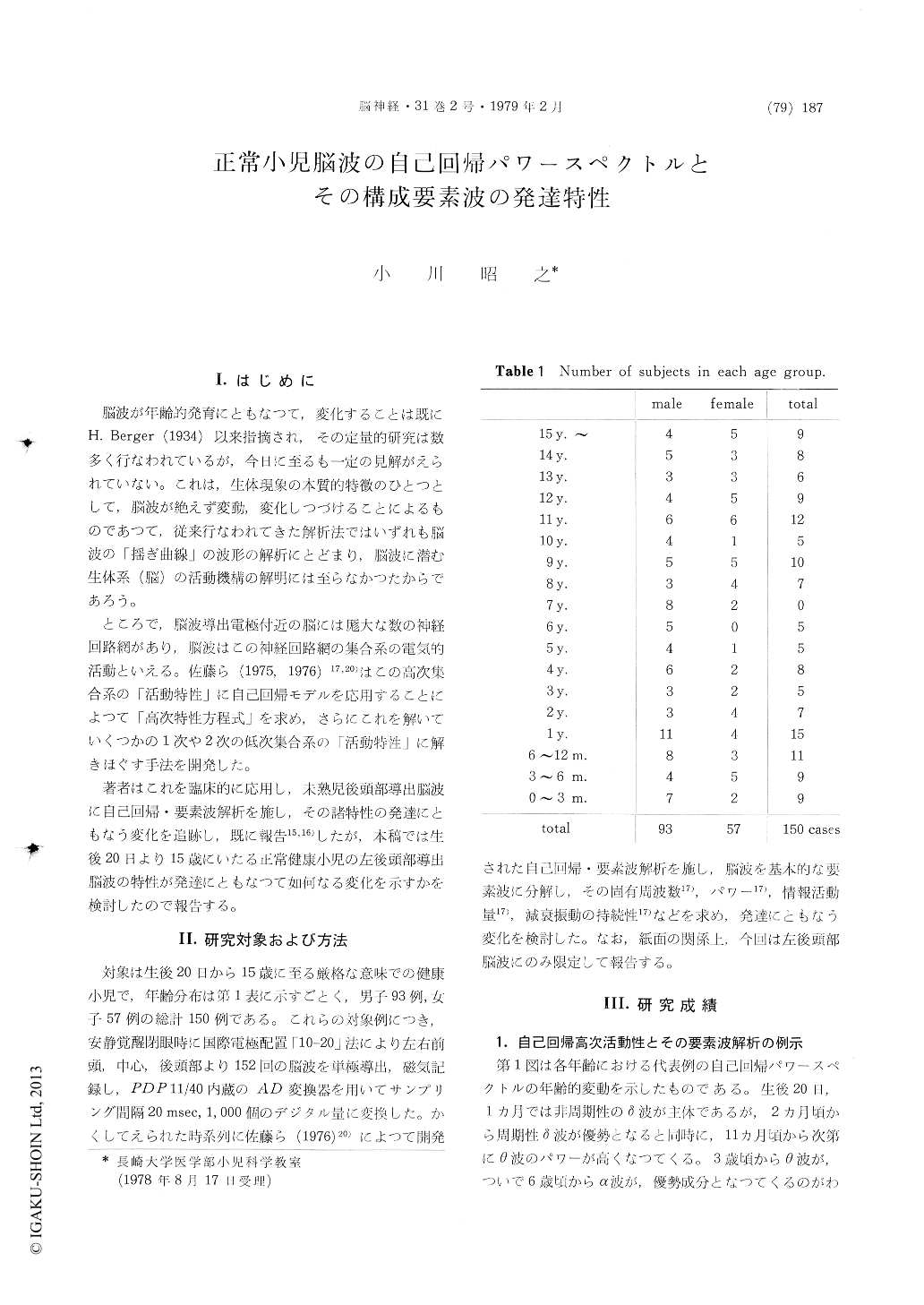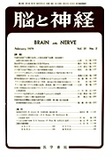Japanese
English
- 有料閲覧
- Abstract 文献概要
- 1ページ目 Look Inside
I.はじめに
脳波が年齢的発育にともなつて,変化することは既にH.Berger (1934)以来指摘され,その定量的研究は数多く行なわれているが,今日に至るも一定の見解がえられていない。これは,生体現象の本質的特徴のひとつとして,脳波が絶えず変動,変化しつづけることによるものであつて,従来行なわれてきた解析法ではいずれも脳波の「揺ぎ曲線」の波形の解析にとどまり,脳波に潜む生体系(脳)の活動機構の解明には至らなかつたからであろう。
ところで,脳波導出電極付近の脳には厖大な数の神経回路網があり,脳波はこの神経回路網の集合系の電気的活動といえる。佐藤ら(1975,1976)17,20)はこの高次集合系の「活動特性」に自己回帰モデルを応用することによつて「高次特性方程式」を求め,さらにこれを解いていくつかの1次や2次の低次集合系の「活動特性」に解きほぐす手法を開発した。
Electroencephalograms of 150 normal children from the age of 20 days through 15 years were recorded. In all instances left occiput monopolar recordings were subjected to autoregressive (AR) power spectrum and component analysis by means of minicomputer (PDP11/40). The twenty second artifact free segment of EEG record was digitized at 50 samples/sec. and the high-order AR-power spectrum was obtained. The high-order AR-power spectrum was decomposed into the first- and second-order elementary processes. The former showed a transient non-oscillatory delta wave, whereas the latter showed damped oscillatory wave of delta, theta, alpha and beta rhythms in EEG. The characteristics of these rhythms in the EEG were given by the frequency, the power-intensity, the bioinformation amount and the damping coefficient, etc., each of which could be given by the AR-coefficient of the high-order AR-process of theEEG (Sato and Ono, 1976). These various EEG parameters has been calculated and mutually compared as regards age. The results may be summarized as follows.
1. Age-dependent changes occurring in the power-intensity and the bioinformation amount has been described (Fig. 3). Under 1 years old group the former increased with age of month, whereas the latter decreased. In older age group both parameters showed decreased with age, markedly in 3 years old.
2. The 152 EEG records were decomposed into 129 first- and 677 second-order activities (Fig. 4). The natural frequency distribution of various frequencies of the EEG second-order components showed several modes of distribution, each of which were enhanced in the frequency range of the well known δ0, δ1, θ1,θ2 α1, α2, β1, β2 and β3 waves re-spectively.
3. The average power percentage of delta wave decreased with age, especially in 1 to 3 years old, whereas those of beta- and alpha-waves increased with the advancing of age. That of theta wave showed a tendency to increase up to 2-4 years of age, followed by its gradual decrease (Fig. 6).
4. The oscillation of components showed signifi-cantly longer duration in δ1, α1 and β3 waves, whereas shorter one in θ1 wave with the age sig-nificantly (Fig. 8,9).
5. The bioinformation amount of alpha wave showed marked increasing from 1 to 3 years, whereas those of delta and theta waves decreased with the age. No significant developmental change was found in beta wave (Fig. 7).
6. The results of this study indicate that the AR-power spectrum and component analysis of EEG constitute a sensitive method which can be applied to detect important information regarding the electrical brain maturation of childhood.

Copyright © 1979, Igaku-Shoin Ltd. All rights reserved.


